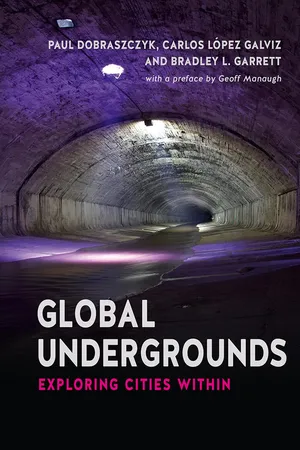![]()
REFERENCES
INTRODUCTION
1 See Bradley L. Garrett, Subterranean London: Cracking the Capital (London, 2014).
2 Rosalind Williams, Notes on the Underground: An Essay on Technology, Society and the Imagination (Cambridge, MA, 1990).
3 Stephen Graham and Lucy Hewitt, ‘Getting Off the Ground: On the Politics of Urban Verticality’, Progress in Human Geography, XXXVII/1 (2013), pp. 71–2.
4 Stephen Graham, ‘Super-tall and Ultra-deep: The Cultural Politics of the Elevator’, Theory, Culture and Society, XXXI/7–8 (2014), pp. 239–65.
5 Eyal Weizman, Hollow Land: Israel’s Architecture of Occupation (London, 2007; revd edn 2012).
6 See, for example, Peter Adey, ‘Vertical Security in the Megacity: Legibility, Mobility and Aerial Politics’, Theory, Culture and Society, XXVII/6 (2010), pp. 51–67; and Stuart Elden, ‘Secure the Volume: Vertical Geopolitics and the Depth of Power’, Political Geography, XXXIV/6 (May 2013), pp. 35–51.
7 Gavin Bridge, ‘Territory, Now in 3D!’, Political Geography, XXXIV/6 (May 2013), p. 55.
8 See, for example, C. López Galviz, ‘Mobilities at a Standstill: Regulating Circulation in London, c. 1863–1870’, Journal of Historical Geography, XLII/1 (October 2013), pp. 62–76. On communications and networks, see Richard Dennis, Cities in Modernity: Representations and Productions of Metropolitan Space, 1840–1930 (Cambridge, 2008); Simon Guy, Simon Marvin and Timothy Moss, eds., Urban Infrastructure in Transition: Networks, Buildings, Plans (London, 2001); Joel A. Tarr and Gabriel Dupuy, eds, Technology and the Rise of the Networked City in Europe and America (Philadelphia, 1988).
9 Peter Sloterdijk, Sphären III: Schäume (Frankfurt, 1999).
10 Williams, Notes on the Underground, pp. 212–13.
11 Kristian H. Nielsen, Henry Nielsen and Janet Martin-Nielsen, ‘City under the Ice: The Closed World of Camp Century in Cold War Culture’, Science as Culture, XXIII/4 (2014), pp. 443–64; also quoted in ‘Under the Ice: Polar Undergrounds’, below.
12 Austin Zeiderman, ‘Securing Bogotá’, Open Democracy, 14 February 2013, www.opendemocracy.net. See also an interview with Alberto Granada, former sewer-dweller, in ‘Sewers of Bogota’, 23 April 2007, www.vice.com.
13 See, for example, Sarah Cant, ‘“The Tug of Danger with the Magnetism of Mystery”: Descents into “the Comprehensive Poetic-Sensuous Appeal of Caves”’, Tourist Studies, III/1 (2003), pp. 67–81; and Maria Alejandra Pérez, ‘Exploring the Vertical: Science and Sociality in the Field among Cavers in Venezuela’, Social and Cultural Geography, XVI/2 (2015), pp. 226–7.
14 Not least, our global search for underground spaces has practical limitations of, for example, language. The References include websites that we came across and that readers might find worth checking. Among these, we highlight the superb collection of photographs and descriptions of underground spaces in Córdoba, Argentina, available at www.speleotunel.com.ar. See also the publications of the Association Française des Tunnels et de L’Espace Souterrain, www.aftes.asso.fr.
15 The French translation from Latin reads: ‘Cette clarté nocturne vient du Firmament, qui n’est autre chose que le revers de la surface de la Terre, dont l’hémisphère donne une lumière pareille à celle, que la Lune rend chez nous; de sorte qu’à ne considérer que cela, on peut bien dire, que sur le globe en question les nuits diffèrent peu des jours, si ce n’est que pendant la nuit le Soleil est absent, & que cette absence rend les soirées un peu plus fraîches.’ Ludvig Holberg, Voyage de Nicolas Klimius dans le monde souterrain, contenant une nouvelle téorie de la terre, et l’histoire d’une cinquiême monarchie inconnu jusqu’à-present (Copenhagen, 1753), p. 16.
ORIGINS
1 David R. Olson and Ellen Bialystok, Spatial Cognition: The Structure and Development of Mental Representations (New York, 2014), pp. 69–71.
2 Edward Soja, ‘Cities and States in Geohistory’, Theory and Society, XXXIX/3–4 (2010), pp. 361–76.
3 Ruth Whitehouse, The First Cities (London, 1977), pp. 71–2.
4 Anthony Clayton, Subterranean City:Beneath the Streets of London (London, 2000); and David L. Pike, Subterranean Cities: The World Beneath Paris and London, 1800–1945 (Ithaca, NY, 2005).
5 See R. Chudley and R. Greeno, Advanced Construction Technology (New Jersey, 2006), p. 179; and see Richard Trench and Ellis Hillman, London Under London: A Subterranean Guide (London, 1993), pp. 105–15.
6 See A.E.J. Morris, History of Urban Form before the Industrial Revolution (London, 2013), pp. 17, 60–61.
7 See John Hopkins, ‘The “Sacred Sewer”: Tradition and Religion in the Cloaca Maxima’, in Rome, Pollution and Propriety: Dirt, Disease and Hygiene in the Eternal City from Antiquity to Modernity, ed. Mark Bradley (Cambridge, 2012), pp. 81–102.
8 On the history and legacy of the Cloaca Maxima, see Hopkins, ‘The “Sacred Sewer”’, and Emily Gowers, ‘The Anatomy of Rome from Capitol to Cloaca’, Journal of Roman Studies, LXXXV (1995), pp. 23–32.
9 See, for example, L. Volloresi, ‘Roma Sotteranea’, National Geographic Italia, XVIII/1 (2006), pp. 2–25.
10 Pliny the Elder, Natural History, Books 36–37, trans. D. I. Fichholz (Cambridge, MA, 1989), pp. 104–8.
11 Victor Cunrui Xiong, Sui-Tang Chang’an: A Study in the Urban History of Medieval China (Ann Arbor, MI, 2000).
12 See ‘Going Underground’, in Neal Bedford and Simon Sellars, The Netherlands (London, 2007), p. 281.
13 Information on these tours can be found at www.maastrichtunderground.nl.
14 Steve Pile, Real Cities: Modernity, Space and the Phantasmagorias of City Life (London, 2005), p. 8.
15 Petrus Gyllius, The Antiquities of Constantinople. With a Descript...
